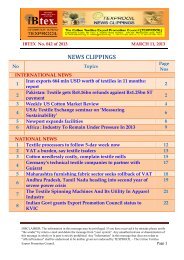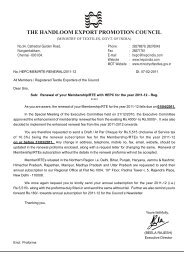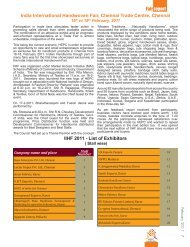Texprocil News1 - Handloom Export Promotion Council
Texprocil News1 - Handloom Export Promotion Council
Texprocil News1 - Handloom Export Promotion Council
Create successful ePaper yourself
Turn your PDF publications into a flip-book with our unique Google optimized e-Paper software.
News Clippings<br />
There are many reasons to shutter a plant. Companies sometimes close<br />
operations as they streamline and modernize—allowing them to consolidate in<br />
fewer locations, often increasing overall output in the deal. That's good for the<br />
economy because it reflects growing productivity, the ability to produce more<br />
with less, which is crucial for lifting living standards over time. But it still can<br />
cost jobs in the short run and suggests manufacturers are far from vibrant.<br />
Tracking the birth and death of factories "isn't a perfect indicator," says Mr.<br />
Meckstroth. "But it's the one thing we have that's most current—and it doesn't<br />
show any revival."<br />
The nation's stubbornly wide trade deficit in manufactured goods is another<br />
trouble sign. If American factories have regained their competitive edge, it would<br />
make sense for them to be selling more abroad as well as at home—trimming the<br />
imbalance. But that hasn't happened.<br />
Another way to gauge competitiveness is to look at the share of manufactured<br />
goods purchased in the U.S. that are imported. This includes everything from<br />
finished products, like a blender, to car parts that are then used in a U.S. factory<br />
to build a vehicle. A revived U.S. factory sector ought to be grabbing more of its<br />
home market, but that also isn't happening, at least not yet.<br />
Mr. Meckstroth estimates that in 2012, imports accounted for nearly 40% of the<br />
manufacturing goods consumed in the U.S.—slightly more than the year before.<br />
Indeed, after dropping a bit during the recession, the share of imports has been<br />
rising for years. It was a mere 9% in 1967, when the government began tracking<br />
this measure.<br />
Many say falling energy costs, driven by the nation's natural-gas boom, will help<br />
fuel a manufacturing revival. But the price of natural gas is only one factor<br />
companies consider when they're deciding where to build.<br />
Goldman Sachs GS +0.49% economist Jan Hatzius, in a recent note to investors,<br />
said "rising productivity, subdued labor costs, low energy prices, and cost<br />
increases abroad have made the United States a much more attractive place to<br />
produce, especially on a relative basis." But he also sees no evidence that a<br />
broader revival is under way.<br />
"Measured productivity growth has been strong," he wrote, "but U.S. export<br />
performance—arguably a more reliable indicator of competitiveness—remains<br />
middling at best."<br />
Some experts insist the renaissance is simply too new to show up in the<br />
numbers. Others point to high-profile cases of companies returning jobs from<br />
overseas as evidence that the tide has turned.<br />
Examples of such "reshoring" range from tiny companies like Sleek Audio, which<br />
moved production of its high-end earphones to Florida from China, to General<br />
Electric Co., GE -0.65% which moved appliance production back to Kentucky<br />
www.texprocil.org.in Page 3












